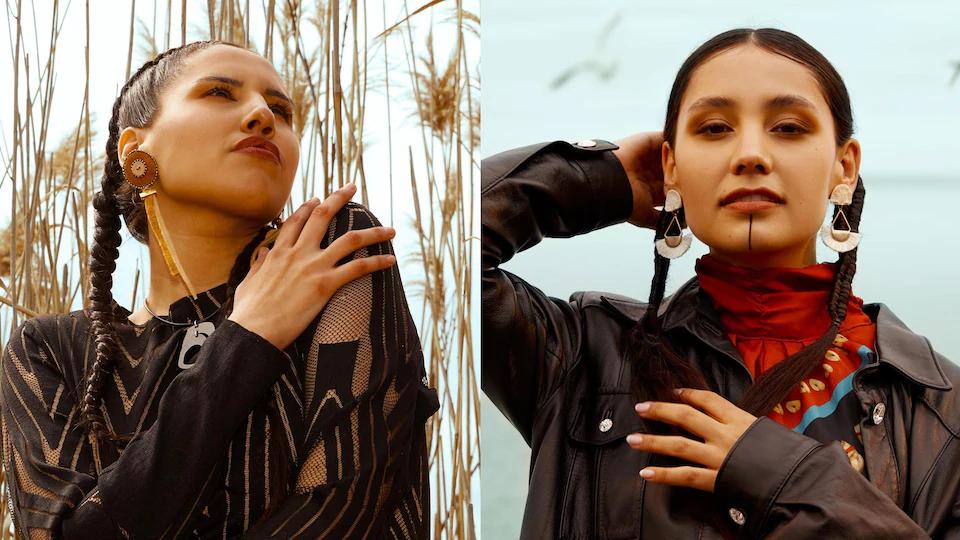Indigenous people are carving out a place for themselves in the fashion and beauty industry
Last June, Canada discovered the insolent beauty of Shina Novalinga, a young Inuk from Nunavik, on the posters of the Sephora brand.
The most connected had already noticed her on social networks, just like Michelle Chubb, a Cree activist.
Shina Novalinga is also a throat singer and spreads this practice on social networks.
Photo: Sephora
The women, both 22, were chosen by the beauty retailer to front a campaign that highlights Indigenous talent
in an effort to amplify the voices of Indigenous peoples across Canada
, according to Deborah Neff, Senior Vice President of Marketing at Sephora Canada.
Recently, the brand of indigenous beauty products Cheekbone Beauty is also highlighted in Sephora stores.
If in its beginnings, Cheekbone Beauty mainly produced lipsticks, it now also offers lip glosses, pencils or face powders.
Jennifer Harper, the founder of Cheekbone Beauty, thinks people want to support racialized entrepreneurs and those from Indigenous communities.
Photo: Cheekbone Beauty
The brand's goal is to create a space in the beauty industry where Indigenous youth feel valued
.
Shina Novalinga recently started selling traditional Inuit jewellery, including sealskin earrings, with her Ikuma brand.
Reitmans, a Canadian chain of ready-to-wear stores, has chosen Innu artist Natasha Kanapé Fontaine for one of its latest campaigns, entitled Diversity is the fiber of Canada
.
We launched a campaign aligned with our values.
Natasha is one of the seven ambassadors with an inspiring journey that we have chosen
, explains Jackie Tardif, president of Reitmans.

The artist worked on the development of the patterns that appear on the t-shirt and the scarf sold by the Reitmans brand.
Photo: Reitmans
Working with Indigenous Peoples
Natasha Kanapé Fontaine thus participated in the creation of a pattern that appears on t-shirts and scarves sold by the brand.
Reitmans had agreed to make a donation of $2 (for a maximum of $10,000, which has already been reached) for the cause chosen by the artist from Pessamit: the Waskapitan fund. This organization notably fights against racism and tends to offer better health services to Aboriginal people.
In an interview, Natasha Kanapé Fontaine explains that the patterns, chosen in collaboration with the Reitmans design team, are inspired by the symbols of her ancestors and her own tattoos.
On the scarf designed by Natasha Kanapé Fontaine and the Reitmans team, we can read the Innu word “Ashineun” which means “pride”.
Photo: Reitmans
How to stop Windows from powering off your USB devices: https://t.co/85oOIBTKPZ https://t.co/UsDNBP8239
— How-To Geek Sat Apr 08 14:35:10 +0000 2017
The goal with the scarf is to seek out this elegance, the pride of women, and to allow, for once, Innu women to see themselves represented in ready-to-wear, she says.
In 2020, the Quebec giant Simons called on eight indigenous designers to launch a clothing line inspired by their cultures.
Among them is Tracy Toulouse, an Anishinaabe from the Ontario community of Sagamok Anishnawbek.
For Tracy Toulouse, her cooperation with Simons is an example of what indigenous design can do in the consumer apparel market.
Photo: Tracy Toulouse
This experience is an example of what Indigenous design can do in the consumer apparel market.
“ Having grassroots Indigenous artists leading production in a niche market allows us to control our participation in that market
,” she tells Indigenous Spaces.
For her line with Simons, she used traditional floral designs. It's been my signature since I started drawing 15 years ago.
Historically, Eastern Woodland flowers were an integral part of daily life for the Algonquin tribes
, she adds.
Culturally, clothing is very important to Aboriginal people. They were a vital part of our way of life, our survival depended on it
, says Tracy Toulouse.
Cultural Appropriation and Opportunism
While the role of Indigenous people in fashion is growing, there's still work to be done, according to Métis designer Jason Baerg, who is also a professor at the University's School of Art and Design. Ontario (OCAD).
In an article published on Radio-Canada, he believes that companies have a duty to provide the support creators need to reach their full potential.
Are they prepared to give the necessary money to native creators so that they can fulfill your orders?
To offer them support throughout the process?
he wonders.
Tracy Toulouse is inspired a lot by floral motifs in her creations.
Photo: Tracy Toulouse
But the issues of cultural appropriation are never far away.
The creations of Tracy Toulouse have also sometimes been looted
, she says.
Michelle Chubb is also very involved in her Manitoba community.
Photo: Sephora
For Reitmans, its campaign is above all a way to amplify the voices of Canadian women by highlighting the diversity of Canada
, insists its president.
All of them brush aside the accusations of a timely marketing move to (re)gild the image of their brand.
There is a place in the fashion industry for Indigenous design, provided it is celebrated and recognized
, concludes Natasha Kanapé Fontaine.
According to her, there are ways to integrate Aboriginal people into this kind of project and the best way is the human way
.








